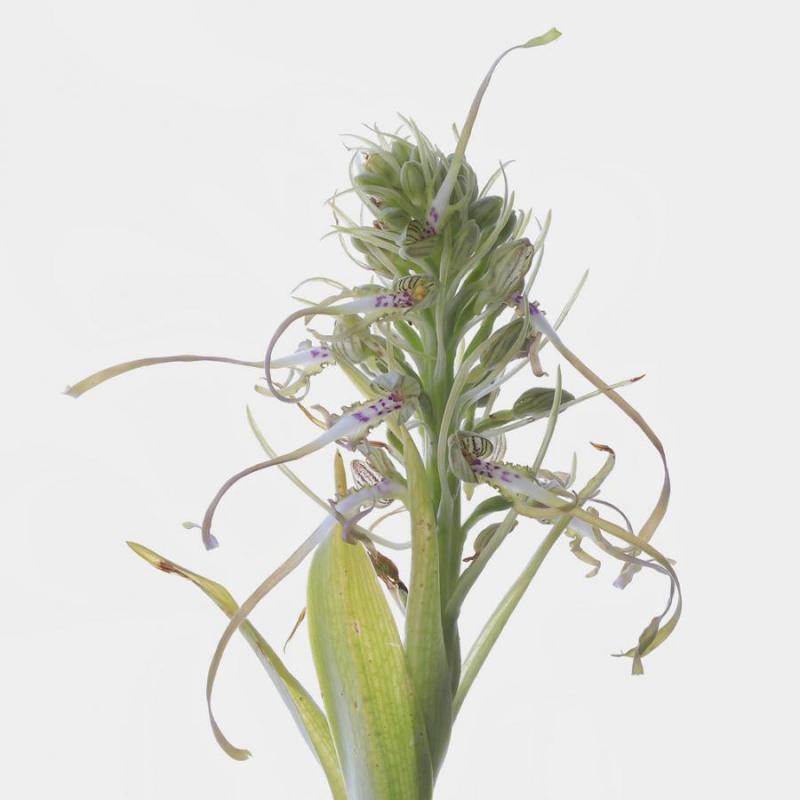Himantoglossum hircinum
Also known as: The Lizard's Tongue Orchid or Orchis hircina Aceras hircina h.v. romana Himantoglossum hircinum var. minusculum Himantoglossum hircinum var. hirsutum Himantoglossum hircinum var. pullum Himantoglossum hircinum var. pendulum Himantoglossum hircinum var. viride Himantoglossum hircinum var. hircinum Himantoglossum hircinum var. confusum Himantoglossum hircinum var. altum Himantoglossum hircinum var. aestivalis Loroglossum hircinum var. minor Himantoglossum hircinum lusus inodorum Himantoglossum hircinum var. praealtum Himantoglossum hircinum f. acutum Aceras hircinum var. forcipula Aceras hircinum var. thuringiacum Himantoglossum hircinum f. purpureum Aceras hircinum var. calamistratum Aceras hircinum var. divergens Himantoglossum hircinum f. brevibracteatum Himantoglossum hircinum f. longelaciniatum Himantoglossum hircinum var. pseudocaprinum Himantoglossum hircinum f. coloriglossum Himantoglossum hircinum f. brevilaciniatum Loroglossum hircinum var. thuringiacum Himantoglossum hircinum f. laxiflorum Himantoglossum hircinum var. heldreichii Himantoglossum hircinum monstr. johannae Himantoglossum hircinum f. forcipula Loroglossum hircinum f. divergens Loroglossum hircinum f. calamistratum Loroglossum hircinum f. forcipula Himantoglossum caprinum var. heldreichii Himantoglossum hircinum var. bracteatum Himantoglossum hircinum f. thuringiacum Himantoglossum hircinum lusus albidum Himantoglossum hircinum var. obtusum Himantoglossum hircinum lusus viridans Himantoglossum hircinum f. divergens Himantoglossum hircinum f. comosum Himantoglossum hircinum f. latisectum Himantoglossum hircinum f. calamistratum in the subfamily: Orchidoideae
Native to: Algeria Austria Belgium Bulgaria Corsica - France Germany Greece Hungary Iraq Netherlands Romania Sicily - Italy Spain Switzerland Tunisia
General Information
The Lizard's Tongue Orchid is a small to medium sized cold to cool growing terrestrial orchid belonging to the sub family Orchidoideae native to Algeria, Austria, Belgium, Bulgaria, France, Germany, Greece, Hungary, Iraq, Netherlands, Romania, Italy, Spain, Switzerland, and Tunisia.
Plant Description
Each new growth has numerous erect lance shaped leaves
Flowers
Numerous blossoms appear during Summer and Spring
Blooming Season
- Spring
- Summer
Care Notes
These orchids grow on the forest floor so are used to rich soil containing plenty of organic matter that is always moist (but not always wet), and prefer constant conditions in terms of humidity, temperature and water supply. They may not be as forgiving as epiphytes in regards to sudden changes in growing conditions so it is wise to ease them into new conditions over a the space of a few days, and repot as infrequently as possible.
Keep an eye on the plants condition regularly as they can decline suddenly if the conditions are not just right. It is more important to keep water supply constant rather than frequent - overwatering often causes rot which can quickly set in, especially in warmer conditions.
These can be grown in shady, moist areas in the garden, supplied they have protection from abrupt changes caused by the elements, e.g. dry winds, frost etc. Being grown around companion plants such as ferns and bromeliads will help build and retain the humidity they require throughout the year.
Climate
These orchids grow in cool climates, at low altitudes, in cool plains, forests or coastal scrub.
They are forgiving of humidity variances as long as temperatures are kept on the cool side. They can do well outdoors in the garden in cool and temperate areas, though it is important that they are protected from warm dry winds. They can enjoy morning sun especially in winter but will need protection from the hot sun in the afternoon and during summer. With some acclimatisation they may be able to receive more sun.
Grows at low to high elevations.
Fertiliser
These plants do well with slow release fertiliser at the rate of 2-3 pellets per cup (250ml) of media. Additional fertiliser during the growth period may be beneficial, but not necessary.
Potting
These plants can be sensitive to repotting though should not require repotting regularly. Repotting should be done when the mix has broken down to the point that it doesn't absorb water or holds onto water for far too long, usually the plant shows a decline in growth as well.
The mix should be free draining, with a blend of 30% inorganic ingredients such as coarse sand, gravel or perlite, mixed in with about 70% organic ingredients such as peat, leaf litter or decomposed bark. Avoid commercial potting mixes as they can vary wildly and may contain "wetting agents" that can hold onto water for loo long, causing rotting and stunted growth.






















